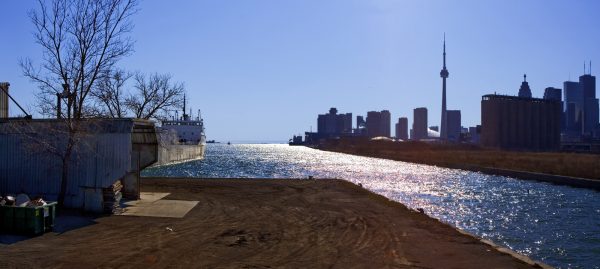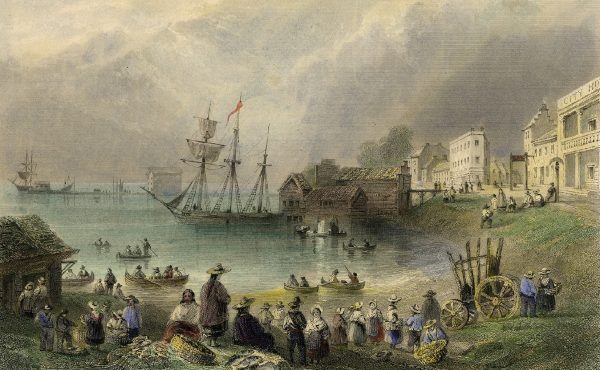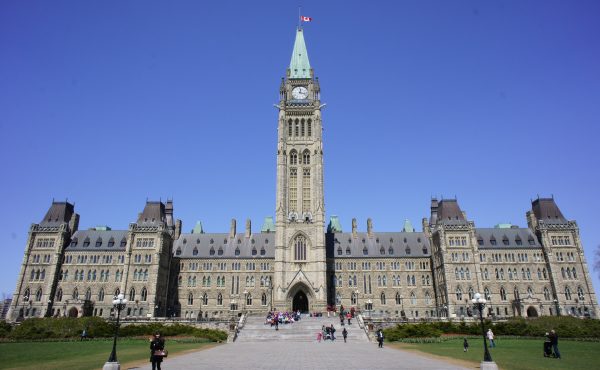The City of Toronto last week clearly signaled to Waterfront Toronto (WT) that the tripartite development agency drastically overstepped its mandate by entertaining a proposal from New York-based Sidewalk Labs to negotiate a deal that could see the Google urban tech subsidiary re-develop the entire Port Lands as well as Quayside, a 4.9-hectare lakefront precinct at the base of Parliament Street.
Senior city officials have told Spacing that they won’t support a proposal from Sidewalk to bundle the smaller parcel with the much larger one — an 325-hectare expanse of mostly fallow industrial and municipally-owned land widely considered to be one of the ripest real estate opportunities in any major North American city.
Council on Friday approved a land use planning framework for the Port Lands that has been four years in making, and has become a lot less theoretical, given the $1.25 billion approved earlier this year to re-construct the mouth of the Don and create a flood protection berm that will allow development in the Port Lands to proceed.
While WT’s RFP, released in the spring, was much more open-ended in scope than the agency’s previous precinct development offerings, there’s little question that it asked bidders to focus on Quayside. “We’ve raised those concerns with [WT],” said deputy city manager John Livey, who described the notion of combining the two parcels under one master development deal as “highly problematic.”
“Waterfront has overplayed their hand a bit,” said another council insider who has been briefed on the process.
A third top official observed that Sidewalk’s ambitious pitch was akin to answering a question that wasn’t on the exam.
In an email to Spacing, Micah Lasher, Sidewalk’s head of external affairs, declined to directly address the company’s current thinking about the Port Lands, referring such queries to WT. “Waterfront Toronto and Sidewalk Labs have already begun meeting with City officials to begin what we expect will be an in-depth collaboration to plan an innovative, complete community on Quayside, which Waterfront Toronto’s RFP documents envision as ‘a pilot environment for the broader eastern waterfront revitalization’….where, ‘technologies, approaches and partners that are deemed to be successful in (Quayside) may be integrated as appropriate in future phases.’”
Waterfront Toronto struck a similarly cautious note. “Discussion in the RFP with respect to the Port Lands was limited to the potential opportunity to take innovative technologies and approaches that are successfully delivered in Quayside to scale in the Port Lands and elsewhere in the City,” WT spokesperson Carol Webb wrote in an email statement to Spacing.
“The RFP also makes clear that the extent to which and how such successful solutions, processes and partnerships are carried forward into subsequent developments on the waterfront could be affected by future additional procurement policies and requirements and approvals by the City of Toronto.” Webb said, however, that some Sidewalk proposals, such as district energy or “innovative approaches to mobility,” would have to be done to scale in order to be feasible.
This messaging is sharply different than the initial positioning promoted by both Waterfront Toronto and Sidewalk earlier in the fall.
As Spacing first reported in late October, SWL’s 196-page vision pitch contained no fewer than 270 references to the “eastern waterfront” (i.e., Port Lands). Sidewalk Toronto’s homepage still features a large map of both areas.
Under the terms of the RFP, WT and Sidewalk have agreed to spend a year negotiating a potential development plan. Sidewalk also indicated it would spend US$50 million on pilot projects over the course of the year, even before it consummates a deal that WT’s board approves.
WT’s request for proposals document, in turn, references the eastern waterfront 15 times, and also includes a map showing both Quayside and the Portlands within a continuous border.
In a related development, North York city councillor and WT board member Denzil Minnan-Wong on Friday obtained council approval on a motion to have the executive committee at its first January meeting vet the framework agreement between Sidewalk and WT, with an eye to determining what kind of City approvals will be required before the two parties can finalize an agreement.
“City council has no visibility into what WT is doing, which I have concerns about,” said Minnan-Wong, who’s been a critic of the deal. “Strictly speaking, the City can’t tell WT what to do. [But] it would be a big mistake for them not to listen if city council takes a position.”
The WT board refused to make public the framework agreement when the deal was announced in October, but eventually released a four-page summary, as the Toronto Star first reported. In an email, Webb said, “We have no issue with [Minnan-Wong’s motion] – City officials including City legal have been fully briefed on and have reviewed the Framework Agreement between Waterfront Toronto and Sidewalk Labs.”
Amidst the initial surge of publicity around the deal, WT CEO Will Fleissig said there would be further details about what was envisioned within 10 days, but no further details have surfaced. City sources don’t expect any details until at least February, but WT officials say they expect. to publish the results of that initial consultation within a week or so.
Nor is it clear what’s going to happen with the promised US$50 million investment pledged by Sidewalk Labs. Because of board confidentiality, Minnan-Wong can’t say whether the funds are contingent on WT agreeing to let Sidewalk sign a deal that includes both Quayside and the Port Lands. “I’m not in a position to answer that question,” he said, adding, “It’s material information in the framework agreement that I’m sure council should be interested in.”
Sidewalk officials declined to comment on whether the US$50 million is a conditional offer based on the outcome of the negotiations over the coming year, nor did they say whether they would release a budget outlining how those funds would be used. Webb said the budget, when finalized, would be made public.
PRIVACY WATCH
In separate news, Sidewalk acknowledged that it is paying Ontario’s long-time former Information and Privacy Commissioner Anne Cavoukian to advise on privacy issues relating to the firm’s data gathering plans. “Ann Cavoukian is being paid to advise Sidewalk Labs on protecting personal privacy and incorporating Privacy by Design into plans and technology,” Micah Lasher said in an email to Spacing.
Cavoukian is currently Ryerson University’s distinguished expert-in-residence in the institution’s “Privacy by Design Centre of Excellence.” In Sidewalk’s public submission to WT’s RFP, the company highlights Cavoukian’s involvement, but only says she has agreed to serve on SWL’s advisory board.
Cavoukian, along with Christopher Hume and Bianca Wylie, appeared on a November 14 panel discussion about the Sidewalk proposal on TVO’s “The Agenda.” She explained that the company had contacted her about embedding privacy into their project, but failed to disclose that SWL was compensating her for her services. As she told host Steve Paikin, “My role in this is to ensure that personally identifiable data associated with individuals who live in the area, citizen, that that remains protected.”






6 comments
I’m sorry, but why does the City of Toronto have no control over Waterfront Toronto? Are they not a City agency?
Excellent reporting as always, John. Aside from the mass media once again missing this, and Spacing being the journal of record on this (I’ve forwarded the link to the Financial Times reporter writing on the larger story, beyond just Toronto’s experience), I’m genuinely perplexed as to why the City would not permit smaller, local, vastly more involved developers who’ve promoted newer and progressive concepts for the area the latitude they need, and yet Waterfront assumes Sidewalk will be given carte-blanch to do as they wish to ‘up-end the order of things’.
Meantime the City buys a plot in the Port Lands to save a film studio in the name of ‘Benevolent Intervention’ all the while disregarding normal market practices. It’s like revolutionary factions fighting amongst themselves…
Chris — Waterfront is a three-level government agency, and while the city has lots of say to WT, they are only partially in control of the agency.
Mimi writes in reply to a very valid question from C King:
[Chris — Waterfront is a three-level government agency, and while the city has lots of say to WT, they are only partially in control of the agency.]
This is a story in itself, not least that the normally labelled ‘right wing’ Minan-Wong was the only one on the board to ask questions, and the rest were a stunned silence. This came up in Lorinc’s prior article reader comments.
I’d quoted a Financial Times article in earlier comments, and will do so again, it is *so* prescient to what John’s article today is about:
[…]In its proposal, Sidewalk also said that Toronto would need to waive or exempt many existing regulations in areas like building codes, transportation, and energy in order to build the city it envisioned. The project may need “substantial forbearances from existing laws and regulations,” the group said.[…]
Alphabet to build futuristic city in Toronto
https://www.ft.com/content/5044ec1a-b35e-11e7-a398-73d59db9e399
That quote is indicative of the first signs of ‘mission creep/arrogance’ on Sidewalk’s behalf. Oddly, I got taken to issue on that quote in a Toronto forum on urban issues, (“No-one said that”) and it didn’t appear in any local media stories either.
Why not? And why does it take a usually marginalized ‘right winger’ and the staid but centrist Financial Times to look at this objectively? I suspect many are mesmerized by the sparkly bits…and overlook the cost and fine print of the contract.
In the event, a number of ‘world class’ news media are asking very pertinent questions, and the TorStar has in a half-hearted way, after the fact.
Meantime in Toronto Lorinc is left to do the heavy lifting to see what’s under the rocks down at the waterfront.
Are there any plans, elevations and sections to review, perspectives and area tabulations ?
The city of Toronto needs a serious shakeup. The Councillors and the process for approval of anything is an absolute joke. The mayor needs a LOT more authority – and also the capability to summarily dismiss Councillors that are acting as “dead wood”. Has anyone ever spoken to these people? They’re half dead.